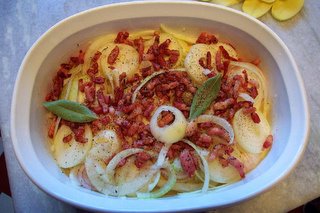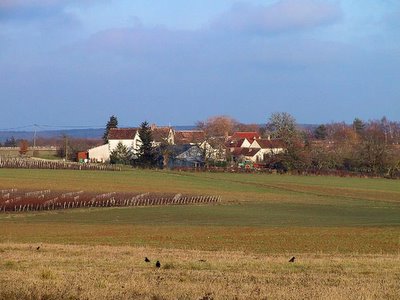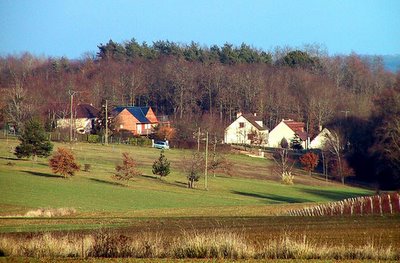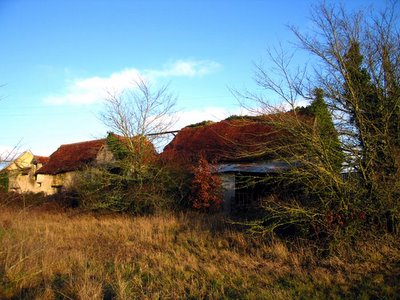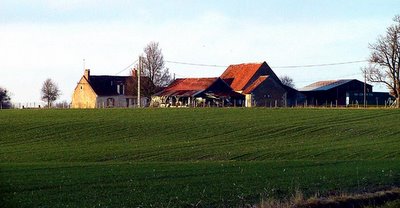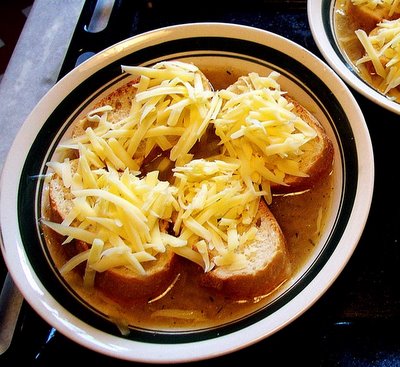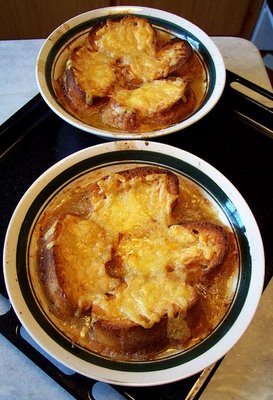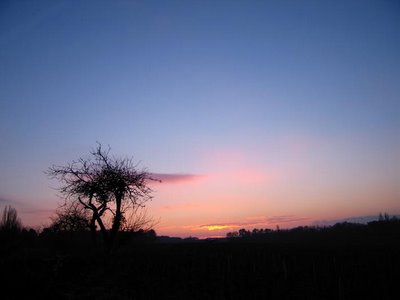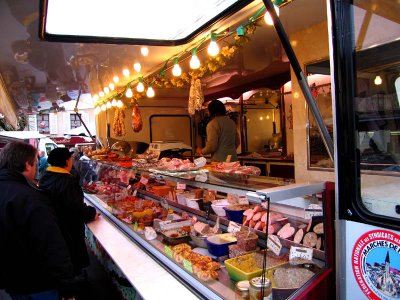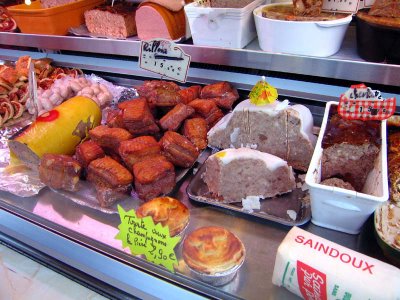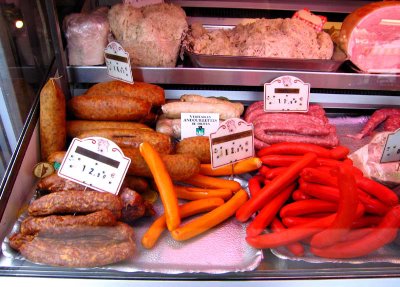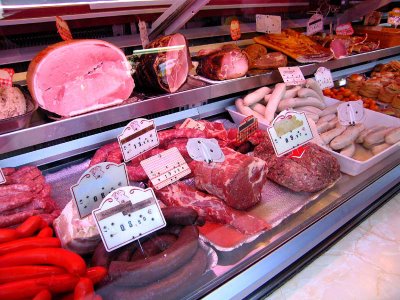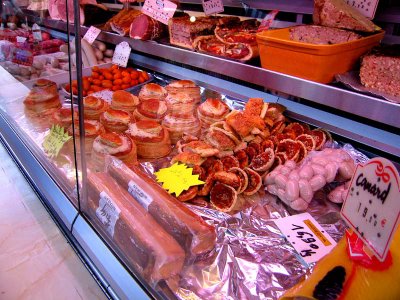(You can click on the pictures to see larger versions.)
 In December 2005, we had very cold weather. It snowed a couple of times at the very end of the month. This picture, taken from the kitchen window, shows our neighbors' house and yard.
In December 2005, we had very cold weather. It snowed a couple of times at the very end of the month. This picture, taken from the kitchen window, shows our neighbors' house and yard. From the front deck, this is another shot of the neighbors' property. They have two lots totaling about 2½ acres. This is their country house, and they spend summers here. Their main residence in in Blois, 25 miles north of us. They bought the country house in 1970 and it was basically a ruin at that point. It's not very big but has a big kitchen, a recently remodeled master bedroom suite, and a dormitory with about a dozen single beds upstairs where the grandchildren sleep.
From the front deck, this is another shot of the neighbors' property. They have two lots totaling about 2½ acres. This is their country house, and they spend summers here. Their main residence in in Blois, 25 miles north of us. They bought the country house in 1970 and it was basically a ruin at that point. It's not very big but has a big kitchen, a recently remodeled master bedroom suite, and a dormitory with about a dozen single beds upstairs where the grandchildren sleep.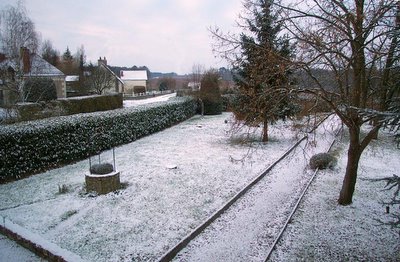 This is the view out of our bathroom window. It's our back yard and the other neighbors' houses. This is about as much snow as we have gotten here in three years. It's really just a dusting, as you can see -- a late friend who lived in Buffalo said it looked as if somebody had sprinkled talcum powder over the whole yard.
This is the view out of our bathroom window. It's our back yard and the other neighbors' houses. This is about as much snow as we have gotten here in three years. It's really just a dusting, as you can see -- a late friend who lived in Buffalo said it looked as if somebody had sprinkled talcum powder over the whole yard. Since January 1, we have had temperatures above freezing and no snow. We had some rain, but not enough -- we are in a drought. Our total rainfall in 2005 was about 17.5 inches, compared to the annual average of 26 inches or more. Above is a view from the bedroom window, taken with a telephoto lens. You can see the vineyards and a man working on pruning the vines and burning the clippings in a custom-made apparatus -- a kind of split-open oil drum on wheels -- used for that purpose. In North Carolina, people use such split-open barrels as barbecue grills, on which they roast whole pigs. People stand around the grill and pinch off piece of meat to eat with their fingers -- hence the name for the event, "pig-pickings." Here they use the same kinds of things for burning grape-vine clippings.
Since January 1, we have had temperatures above freezing and no snow. We had some rain, but not enough -- we are in a drought. Our total rainfall in 2005 was about 17.5 inches, compared to the annual average of 26 inches or more. Above is a view from the bedroom window, taken with a telephoto lens. You can see the vineyards and a man working on pruning the vines and burning the clippings in a custom-made apparatus -- a kind of split-open oil drum on wheels -- used for that purpose. In North Carolina, people use such split-open barrels as barbecue grills, on which they roast whole pigs. People stand around the grill and pinch off piece of meat to eat with their fingers -- hence the name for the event, "pig-pickings." Here they use the same kinds of things for burning grape-vine clippings. Above is a recent sunrise. There was heavy fog, and the sun came up as a glowing disk on the horizon, visible through the bare tree limbs. It looks more like the moon rising, doesn't it?
Above is a recent sunrise. There was heavy fog, and the sun came up as a glowing disk on the horizon, visible through the bare tree limbs. It looks more like the moon rising, doesn't it?Sunrise and sunset are special times of day here. It's always a treat to open the shutters on the kitchen window, which faces east, at about 8:00 a.m. on a winter morning and see what the day looks like. One of the things I love about living here is that clanging and clattering noise of opening shutters in the morning. Why don't we have shutters on our windows in America?
 And this was a sunset last week. The sunsets are the best. This is the view from the bedroom window, boosted by a telephoto lens. The colors are authentic.
And this was a sunset last week. The sunsets are the best. This is the view from the bedroom window, boosted by a telephoto lens. The colors are authentic.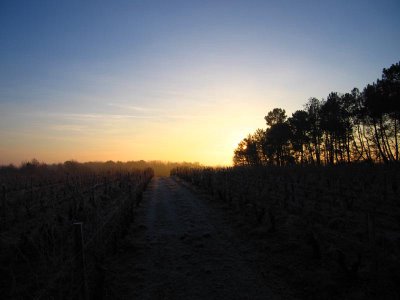 Here's another sunrise. I was out walking the dog in the vineyards behind our house. We are lucky to be the last house on the road, which turns into a gravel tractor path just at the end of our yard. It's like having a back yard that covers 15 or 20 acres.
Here's another sunrise. I was out walking the dog in the vineyards behind our house. We are lucky to be the last house on the road, which turns into a gravel tractor path just at the end of our yard. It's like having a back yard that covers 15 or 20 acres. That same morning, there was a heavy frost and the air was clear and still. The sun was just coming up over the horizon. The oak trees along the paved road don't lose their leaves in the fall the way other trees do. The rust-colored leaves just hang there all winter. I guess the new growth of leaves pushes the old ones off in the spring. This particular December morning, the sunlight was striking them just right, so that the contrast between the leaves and the frosty grass was spectacular.
That same morning, there was a heavy frost and the air was clear and still. The sun was just coming up over the horizon. The oak trees along the paved road don't lose their leaves in the fall the way other trees do. The rust-colored leaves just hang there all winter. I guess the new growth of leaves pushes the old ones off in the spring. This particular December morning, the sunlight was striking them just right, so that the contrast between the leaves and the frosty grass was spectacular. This is another sunset shot. The sun is going down off the left side of the picture. The sky is clear, with just a layer of clouds off to the north, over the vineyards. That way is Brittany and Normandy, 100 miles distant.
This is another sunset shot. The sun is going down off the left side of the picture. The sky is clear, with just a layer of clouds off to the north, over the vineyards. That way is Brittany and Normandy, 100 miles distant. These are the woods closest to our house. The little deer called roe deer (chevreuils in French) live in these wooded areas. They are about the size of a big dog, and we see them all the time around here.
These are the woods closest to our house. The little deer called roe deer (chevreuils in French) live in these wooded areas. They are about the size of a big dog, and we see them all the time around here.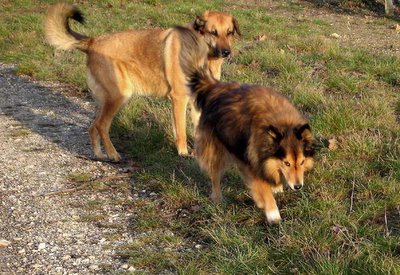 Oops. Picture number eleven. So much for the accuracy of titles (see above, the title). Saturday 1/14 was an especially nice day. Collette and I went out for a walk in the vineyard and we ran into the guy who prunes the vines and who has a dog named Max. Max and Collette have recently started to be friendly, after months or even a year or two of avoiding each other. And on Saturday I noticed for the first time that Max is a female -- her name must be Maxine. I had always thought that Max was Maxime and a male. The two dogs get along fine. Collette just turned 14, and Max is a lot younger.
Oops. Picture number eleven. So much for the accuracy of titles (see above, the title). Saturday 1/14 was an especially nice day. Collette and I went out for a walk in the vineyard and we ran into the guy who prunes the vines and who has a dog named Max. Max and Collette have recently started to be friendly, after months or even a year or two of avoiding each other. And on Saturday I noticed for the first time that Max is a female -- her name must be Maxine. I had always thought that Max was Maxime and a male. The two dogs get along fine. Collette just turned 14, and Max is a lot younger.









